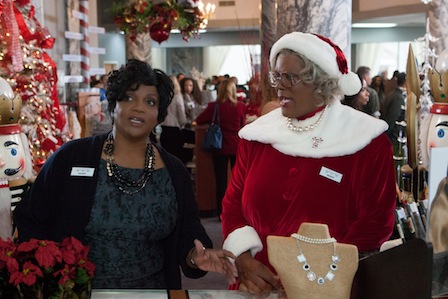DIANA DELLACAVA
Many people welcome the winter months with open arms and ready knit hats and scarves.
A traditional activity during this time is movie-going, for you may relax and immerse yourself in a world of candy canes and mistletoe. Now a days, however, options are much more limited than expected.
The presence of Christmas films has declined dramatically, due to the demand for realism in film by the older movie viewers and the demand for horror films by the younger demographic.
The Secret Life of Walter Mitty, for instance, opens to the public on December 25. In this film, far from a Santa Claus figure, Ben Stiller is a dreamer who delves so deep into his fantasies he spends half of his time daydreaming.
Teens, in turn will be watching other teens fight to the death well into January when may watch Paranormal Activity: The Marked Ones.
The Hunger Games: Catching fire has reached $186 million domestically and nearly $350 in the worldwide film market by the end of November, according to The Wrap Hollywood News Inc.
The teenage driving force behind the success of first the book trilogy written by Suzanne Collins, and now the Lionsgate films has helped the crude dystopia that serves as the film’s nucleus achieve success in only days after its November 22 opening.
It seems the film industry is trying hard to fulfill the demands of as many viewers as possible in order to increase revenue and attempt to fill theaters in the winter months.
There were 28 films scheduled to release starting on Friday, December 6, according to movieinsider.com. From these titles, 17 are dramas without a holiday theme, thus leaving 11 films in a cluster of thrillers, adventures, documentaries and family films.
Amy Herzog, a Queens College professor and media expert, points out that in the past years some holiday movies have had a darker tone.
“There have been movies like Bad Santa and [more recently] Almost Christmas,” she said. “Which have a very cynical and kind of poignant take on the different experiences people go through during Christmas time.”
In Almost Christmas, released in April 2013, Paul Giamatti and Paul Rudd, having moved away from a criminal past, find the Christmas holiday to be the perfect money making machine.
This trend, Herzog said, favored by an older generation, pulls the viewer away from traditional holiday films, disposing of the Santa Claus figure and in addition fostering a fatalistic view of life.
Another way to twist the Christmas story to fit tastes that are more varied is to incorporate horror. The 1974 film Black Christmas for instance, is also available today as a 2006 remake of the same title. In both films, a disgruntled young boy paints Christmas black by murdering his family, and 15 years later comes home for the holidays as a full grown maniac to find his home occupied by sorority girls. The modern version features hot young actors in a film industry effort to follow modern trends in film viewership — thus providing an alternative for horror fans out there.
There are two comedies available: the Ben Stiller film and the only Christmas film: Tyler Perry’s A Madea Christmas. Aside from the meager number of holiday films available, this film is group specific which defies the scope of a universal holiday films.
Ideally, Hollywood productions for Christmas feature a varied cast as to help the public identify with characters of different backgrounds. This is not to say that someone of a different ethnicity would not enjoy such a film.
Herzog said light-hearted films such as Best Man Holiday, released in November and the upcoming Madea Christmas, are highly appropriate for the holiday season, generally good time to release films.
“From a stark marketing point,” she said. “People try to release films around the holiday.”
The college crowd, in particular does not often plan-ahead when it comes to movie theater trips, often watching what is available, when there is time and if there is anytime. When choosing a holiday film to watch this winter, students will have the choice already made for them.
Not everyone shares the holiday spirit with the same degree of intensity. However, a point of mutual agreement across the generations is the unrequited love for classic holiday films.
In speaking to media professors and students, while some would rather skip the Christmas film altogether, most will find it most enjoyable in the comfort of their own homes and the warmth of their pajamas.
These films are widely available and easily accessible through all kinds of online services such as Netflix streaming, and Amazon or iTunes downloads without having to leave the house.
General audiences and film professionals alike have been turning to the classic holiday films. Titles such as Miracle on 34th Street and It’s a Wonderful Life fill living rooms with joy higher than a cupful of eggnog.
While others like Charles Dickens’ A Christmas Carol, and White Christmas extend the offer of a happier life, which we can accomplish by making better choices.
“Our ideas of Christmas are so steeped in nostalgia,” Herzog said. “It makes sense that we revert to the classics when it comes to Christmas.”
Moreover, childhood favorites such as A Charlie Brown Christmas and Dr. Seuss’s How The Grinch Stole Christmas can take us back to a time of childlike dependency, regardless of how mature our beloved Peanuts characters can be and how cynical Dr. Seuss’s script is.
These films have become unchallenged classics because less of the genre are produced as time goes by, where in 2011 and 2012 there were only three holiday films released but plenty of drama and horror filled the box office.
The type of comfort, whether it be spiritual, or physical found at home is something the movie industry has virtually stopped trying to recreate inside the theater.
RECOMMENDED STORIES
- Whitestone family wins ‘Great Christmas Light Fight’ on ABC
- VIDEO: Bayside homes musically light up for holidays
- NY Hall of Science gingerbread village sets record for world’s largest
































